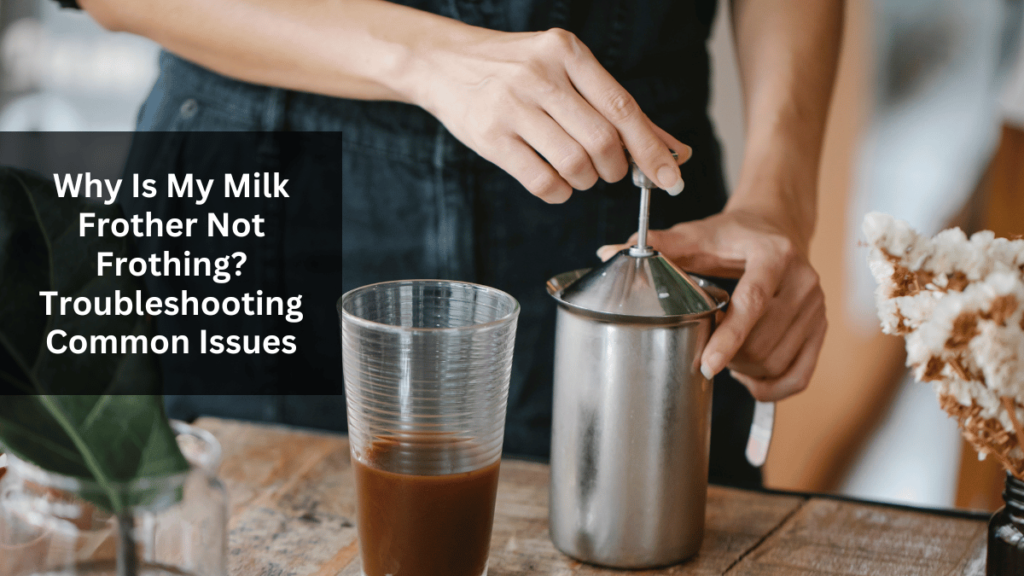A milk frother helps achieve the perfect foam for your lattes, cappuccinos, and other coffee delights. However, it can be frustrating when your frother doesn’t produce the expected frothy goodness. There are several reasons why your milk frother might not be frothing as it should, and understanding these can help you troubleshoot and enjoy your frothy drinks once again.
Understanding the Type of Milk Used
Milk Fat Content and Frothing Ability
The type of milk you use significantly affects how well it froths. Like whole milk, milk with a higher fat content tends to produce a creamier foam but may achieve a different volume than low-fat or skim milk. Skim milk, however, creates a lighter, airier foam. If your frother isn’t frothing, consider switching to a different type of milk. For instance, 2% milk generally offers a good balance between volume and creaminess.
Non-Dairy Alternatives and Frothing
Non-dairy milk, such as almond, soy, or oat milk, has different frothing properties than dairy milk. Some non-dairy milks contain stabilizers or emulsifiers that help with frothing, but others do not. If you’re using non-dairy milk and not getting the desired foam, you might need to try a brand labeled “barista” or “froth-friendly.” Barista versions are formulated to froth better.
Temperature Matters
The Ideal Milk Temperature for Frothing
Milk temperature is crucial for frothing. The optimal temperature is between 140°F and 155°F (60°C to 68°C). If the milk is too cold, it won’t foam well; if it’s too hot, the proteins can break down, preventing froth formation. A thermometer to monitor the temperature can help you create the perfect foam.
Cold Frothing Considerations
Some frothers are designed to froth cold milk, but not all do so effectively. If you’re trying to froth cold milk and not getting any results, ensure your frother is capable of cold frothing. Also, remember that cold milk generally produces less foam than warm milk, so manage your expectations accordingly.
Frother Maintenance and Cleanliness
Keeping the Frother Clean
A dirty frother can hinder its performance. Milk residue can build up on the frother’s whisk or inside the frothing chamber, affecting the frothing process. Regularly, it is essential to clean your frother after each ial. Use warm, soapy water to clean the whisk and chamber, and rinse thoroughly. Some frothers are dishwasher-safe, but always check the manufacturer’s instructions.
Checking for Wear and Tear
Over time, parts of the frother, like the whisk or motor, may wear out, leading to reduced frothing efficiency. If your frother has seen better days, it might be time to replace the whisk or, in some cases, the entire frother. Regular maintenance and replacing worn-out parts can keep your frother working like new.
Power and Frother Settings
Ensuring Adequate Power Supply
Sometimes, the issue might be as simple as an inadequate power supply. If your frother is battery-operated, ensure the batteries are fresh and fully charged. For electric frothers, ensure the device is plugged into a working outlet and the power cord is not damaged.
Understanding Frother Settings
Many frothers come with different settings for frothing and heating milk. Ensure you’re using the correct setting for the type of foam you want. If your frother has multiple whisk attachments, make sure you’re using the right one. Some frothers have a separate whisk for heating milk without frothing, so double-check you’re using the frothing whisk.
Milk Frother Design Limitations
Understanding Your Frother’s Capabilities
Different frothers have varying capabilities; not all are designed to produce the same type or amount of foam. Some handheld frothers may make less saliva than a standalone electric frother. Understanding your father’s limitations can help you manage your expectations. Investing in a high-quality electric frother might be necessary if you’re looking for a rich, café-style foam.
Frothing Capacity
Overfilling the frother can prevent proper frothing. Frothers typically have a maximum fill line, and exceeding this can cause the milk to overflow or not froth correctly. Always follow the manufacturer’s guidelines on how much milk to use for frothing.
Altitude and Atmospheric Pressure
Impact of High Altitude on Frothing
Altitude and atmospheric pressure can have a surprising effect on milk frothing. At higher altitudes, the boiling point of water decreases, which can impact how milk behaves during frothing. The lower air pressure at higher elevations means the frothing process might produce more giant air bubbles, resulting in a less dense foam. This could be a contributing factor if you live at a high altitude and struggle to get a good foam. To counteract this, you should experiment with different milk or frothing techniques, such as frothing for a longer time or slightly warmer milk.
Environmental Factors
Humidity and Its Effect on Frothing
Humidity can also play a role in how well your milk froths. High humidity can make it harder to achieve stiff peaks in your foam, as the moisture in the air can interfere with the formation of microbubbles in the milk. On the other hand, arid conditions might cause the milk to froth more quickly, but the foam may be less stable and collapse faster. To optimize frothing in different humidity levels, consider using milk at the ideal temperature and adjusting your frothing time accordingly. In highly humid conditions, it might be helpful to froth the milk in a cooler, air-conditioned environment to reduce the moisture in the air.
Milk Freshness
Using Fresh Milk for Optimal Frothing
The freshness of your milk is crucial for achieving the best foam. Older milk may also not froth because the proteins and fats contributing to froth formation degrade over time. Fresh milk contains more intact proteins and fat globules, essential for creating a stable foam. If you’ve been using milk sitting in the fridge for a while, try using a fresh carton to see if that improves your froth. Additionally, ensure that your milk is stored correctly, as milk exposed to air or light for extended periods can lose its frothing capability.



